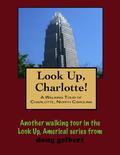There is no better way to see America than on foot. And there is no better way to appreciate what you are looking at than with a walking tour. Whether you are preparing for a road trip or just out to look at your own town in a new way, a downloadable walking tour is ready to explore when you are. Each walking tour describes historical and architectural landmarks and provides pictures to help out when those pesky street addresses are missing. Every tour also includes a quick primer on identifying architectural styles seen on American streets. Charlotte was founded in the mid-1700s by Scotch-Irish and Germans traveling down from Pennsylvania. The town and the county were named for Queen Charlotte of Mecklenburg-Strelitz, the wife of King George III of England. Fertile lands drew the early settlers and the nation's first gold rush - really more of a flurry - took place in the early 1800s after Conrad Reed found a 17-pound rock on his family farm in nearby Cabarrus County that he used as doorstop which turned out to be nearly solid gold. The United States opened the Charlotte Mint in 1837 as the area led the nation in gold production until the great strikes in California in 1848.Still the population scarcely scraped above 2,000 at the outbreak of the Civil War. After the war the area slowly transitioned from agrarian to manufacturing. The population topped 10,000 for the first time in 1890 as textile manufacturers primed the economy for explosion. By 1930 Charlotte passed Winston-Salem as the largest city in North Carolina and never looked back. Today the population is 750,000. In the process the city seamlessly segued from manufacturing center to financial center and in 2011 only New York City is a bigger banking city. When a city explodes as quickly as Charlotte there is not much time to argue about preservation and we will only encounter a handful of buildings on our tour that don't have a modern pedigree. As a counterbalance to the shiny high-rises we will also visit t
-
- Categories
- Other
- Australia
- China
- New Zealand
- United States
- United Kingdom
- France
- Spain
- Italy
- Turkey
- Germany
- Malaysia
- Mexico
- Austria
- Russia
- Ukraine
- Thailand
- Saudi Arabia
- Greece
- Canada
- Poland
- Netherlands
- Singapore
- Hong Kong
- Taiwan
- South Korea
- Japan
- Brazil
- Argentina
- Indonesia
- Vietnam
- India
- Morocco
- South Africa
- Tunisia
- Zimbabwe
- Algeria
- Kenya
- Egypt
- United Arab Emirates
- Syria
- Jordan
- Iran
- Israel
- Qatar
- Dominican Republic
- Chile
- Puerto Rico
- Peru
- Uruguay
- Costa Rica
- Mauritius
- Sweden
- Nepal
- New
- Popular
- Gifts
- Videos
- Help / Contact Us
- Terms & Privacy
- What is TripTerest


